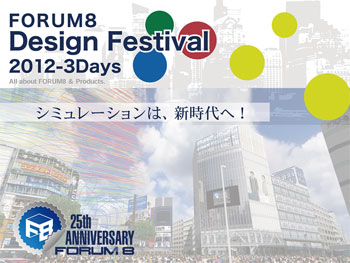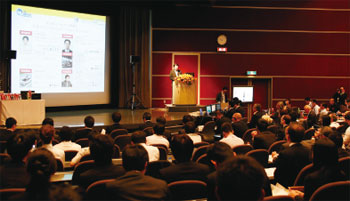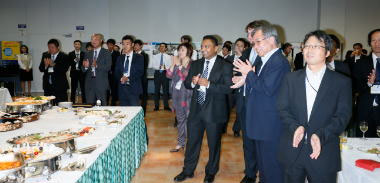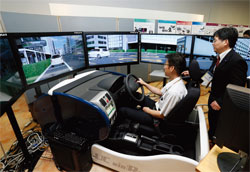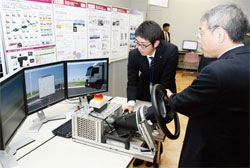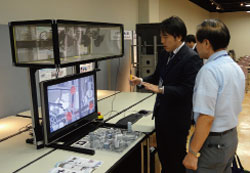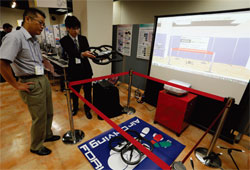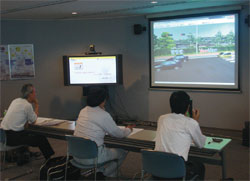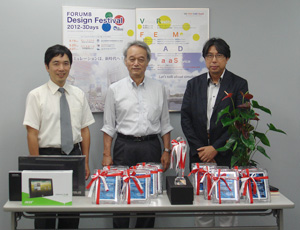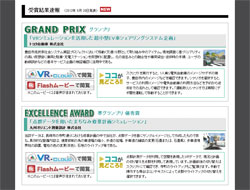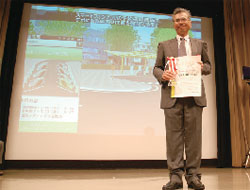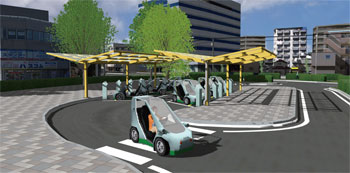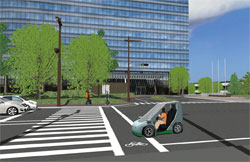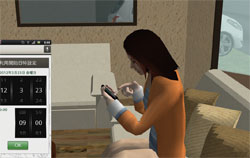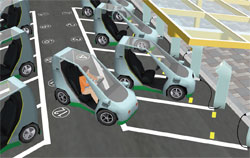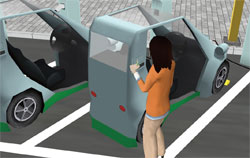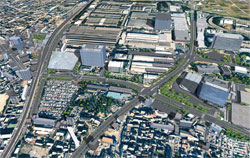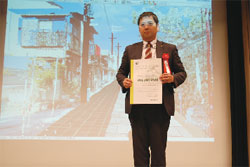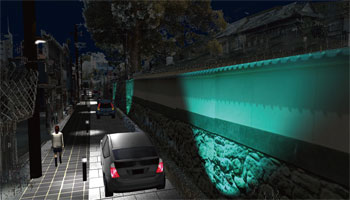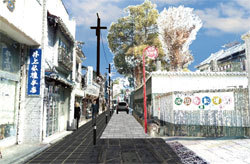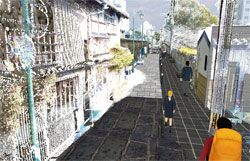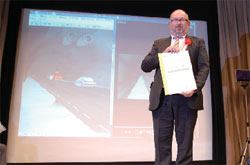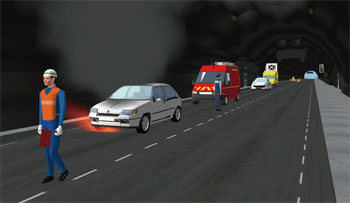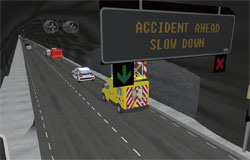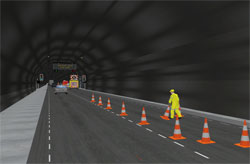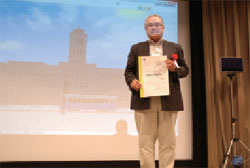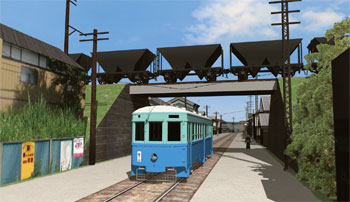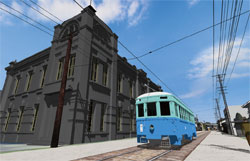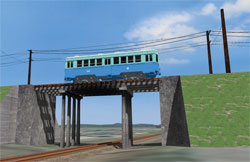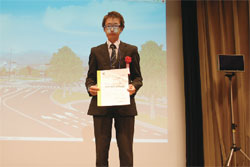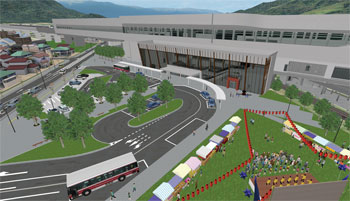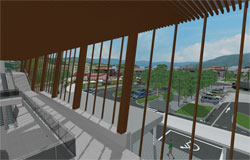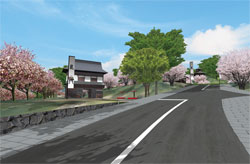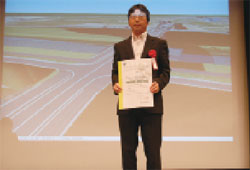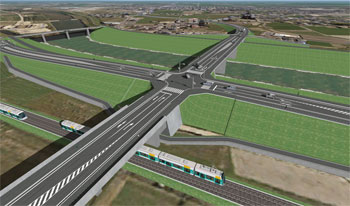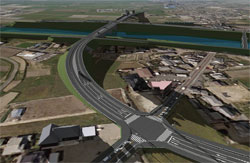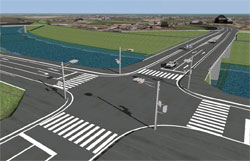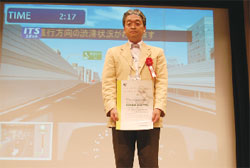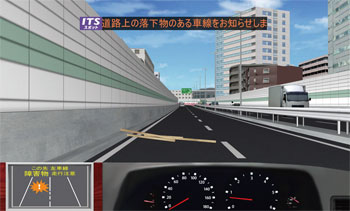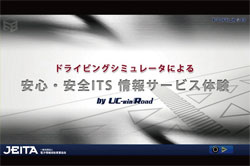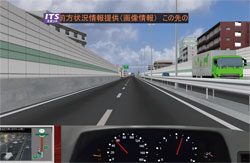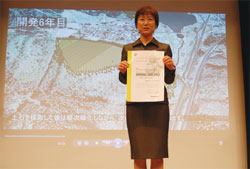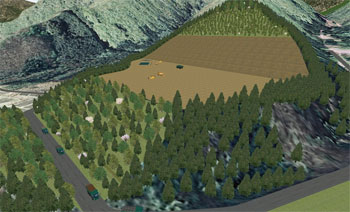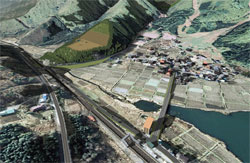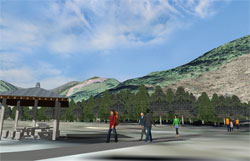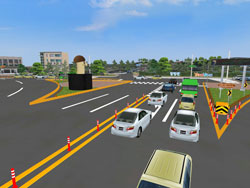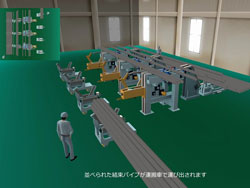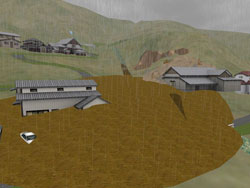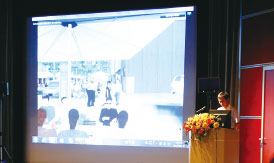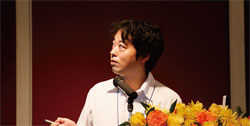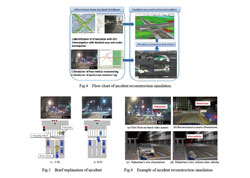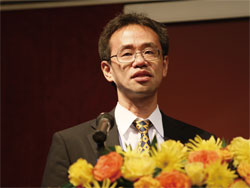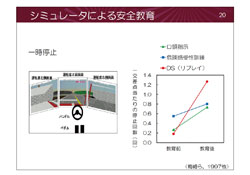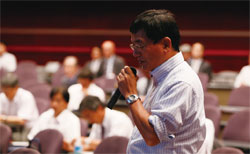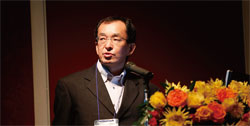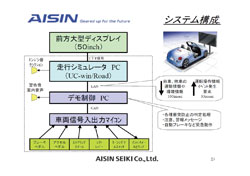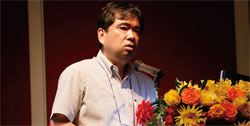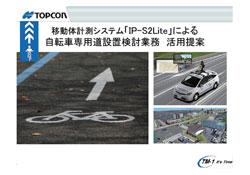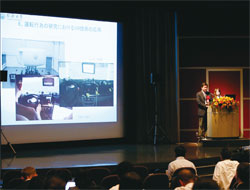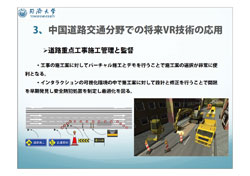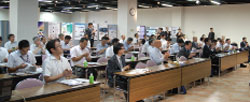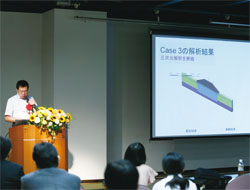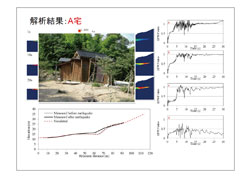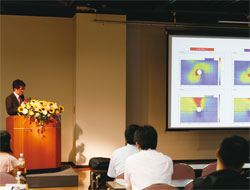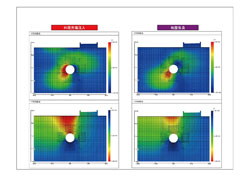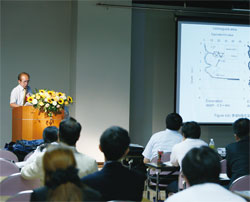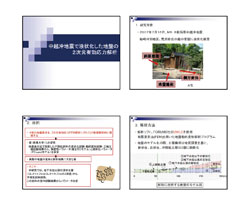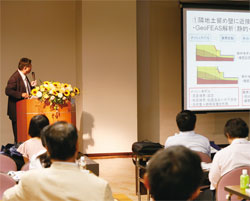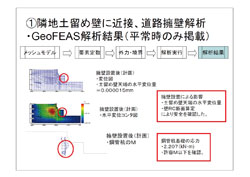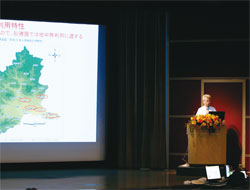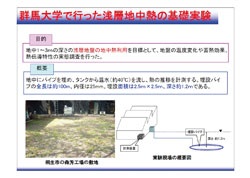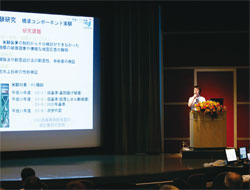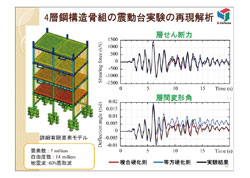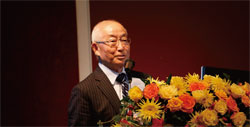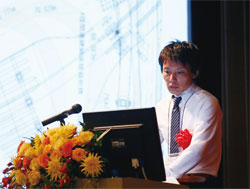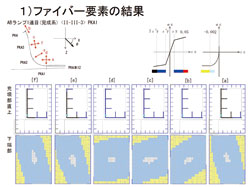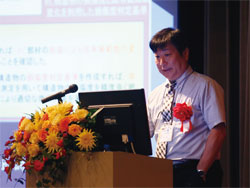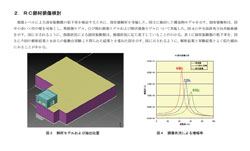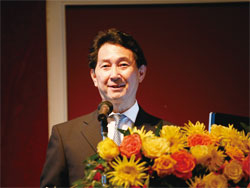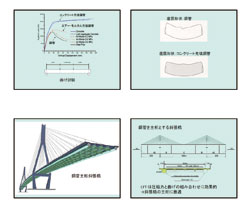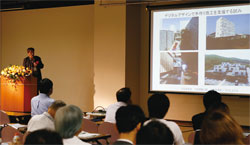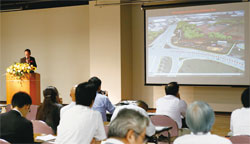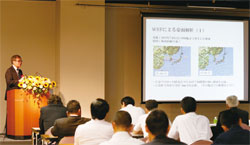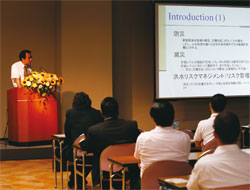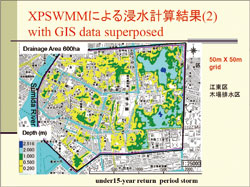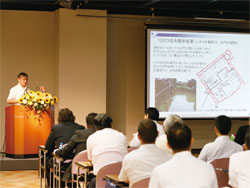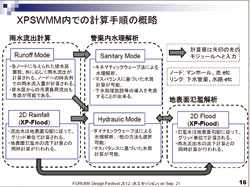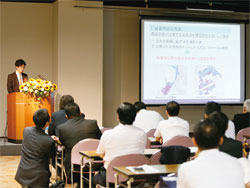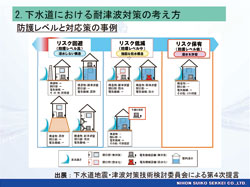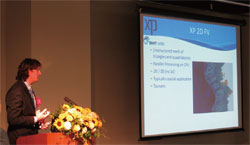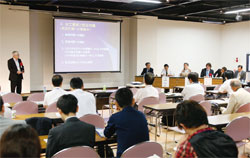| Date: September 19-21, 2012 Venue:Kokuyo Hall, Shinagawa (Day 2 and 3) Supported by:Computer Graphic Arts Society (CG-ARTS) and International Alliance for Interoperability Japan Association |
(Up&Coming New Year, 2013) | |||||||||||||||||||||||||||||||||||||||||||||||||||||||||||||||||||||||||||||||||||||||||||||||||||||||||||||||||||||||||||||||||||||||||||||||
Organization of the 25th Anniversary Event On Day 1 of FORUM8 Design Festival, the final judgment of "the 11th 3D - VR Simulation Contest on Cloud" was held in the seminar room in our Tokyo head office. Ahead of this, 11 works had been nominated from among entries. Then using VR-Cloud®, a method adopted since the previous year, open public voting was conducted on the Web for each work. After considering the result of judgment by the selection committee members and this public voting, each prize was decided on the day. From the next day the place was moved to Kokuyo Hall in Shinagawa. Its main hall and multi-purpose hall were used for operating several sessions of the Design Festival simultaneously. On Day 2, "VR Conference" was held in the main hall. In the morning, presentation of the prizes of "the 11th 3D - VR Simulation Contest on Cloud" and the prize-giving ceremony were conducted. From the afternoon, sessions of "the 13th UC-Win/Road Conference" were held with focus on driving simulation. In the multi-purpose hall, on the other hand, <Geotechnical analysis session> out of "the 6th Design Conference" was held throughout the morning and afternoon. Furthermore, after all lectures were over on the day, a publishing commemorative party for "Introduction to Libre Office for Engineers" (published by FORUM8 Publishing) was held in the hall that also served as the 25th anniversary party. On the final day of the Design Festival (Day 3), the main hall was used for <Civil design / analysis session> of "the 6th Design Conference" in the morning, and <Civil design / General session> in the afternoon. The multi-purpose hall was used for <Architecture / BIM session> in the morning and <Hydraulic engineering session> in the afternoon, respectively. Besides, through Day 2 - Day 3, an exhibit corner was set in the multi-purpose hall. We had many visitors experience the latest functions and services including the 7 channel driving simulator (cluster system), simulators, and UC-win/Road Ver.8. Overviews of these events and sessions are mentioned below.
Day 1 (September 19th) The 11th 3DVR Simulation Contest on Cloud Using Cloud That Enables Extensive Participation in the Voting Process The opening program of the Design Festival (September 19, 2012) was the final judgment of "the 11th 3D - VR Simulation Contest on Cloud". This was established after UC-win/Road had received "Software Product Of The Year" prize (2002). Three people, Mr. Hiroo Kasagi (NPO Workshop for Sustainable Community) - Mr. Fumio Seki (Nihon University) - Mr. Tatsuoki Inagaki (Pave & Road How-To Way Technology Association), were commissioned to become judges of this contest. Ahead of the final contest, 11 works had been nominated from among entries through preliminary selection on September 4. These works are opened to the public using VR-Cloud® just as last year for general voting, in which a wide range of relevant people took part during September 7-17. After this process, the final judgment is carried out to determine prizes by adding up ranking points with weight of 70% on general voting and 30% on FORUM8 selection committee. On the next day, September 20th (Day2 of Design Festival), the results were announced with an award ceremony. The prizewinners and their works of "the 11th 3D - VR Simulation Contest on Cloud" are as follows.
|
||||||||||||||||||||||||||||||||||||||||||||||||||||||||||||||||||||||||||||||||||||||||||||||||||||||||||||||||||||||||||||||||||||||||||||||||
|
||||||||||||||||||||||||||||||||||||||||||||||||||||||||||||||||||||||||||||||||||||||||||||||||||||||||||||||||||||||||||||||||||||||||||||||||
Day 2 (September 20th) The 13th VR Conference Application Scenes of VR Spreading by Way of Coordination with Cloud Advanced Technologies Related with Driving Simulation On Day2 of the Design Festival, events and sessions that constitute "VR Conference" were held in the main hall between 2 places of the KOKUYO Hall. Specifically, in the morning "the VR Conference" was opened by a lecture, which was followed by the result announcement and award-giving ceremony of "the 11th 3D - VR Simulation Contest on Cloud". In the afternoon "the 13th UC-Win/Road Conference" was held. "UC-win/Road Conference" started in 2000 after the release of "UC-win/Road". Since then, it has been held every year. Since "VR-Studio®" was released in 2009, it has also serving as "VR-Studio® Conference". This is the 13th time in this form. Enhanced Recognition of Characteristics of VR and its Use Widespread "VR Conference" began with a special lecture by Prof. Tomohiro Fukuda, Associate Professor in the Division of Sustainable Energy and Environmental Engineering, Graduate School of Engineering, Osaka University, majoring in the Environmental Design and Information Technology, entitled "Utilization of cloud computing VR and SNS and their future vision". First Prof. Fukuda enumerated his activities about town planning and urban design using VR. Among these, he focused on the consensus building method that diverse participating parties perform while sharing three-dimensional (3D) virtual spaces in a distributed synchronous environment, as well as efforts to explore possibilities of utilization of cloud computing VR in order to realize the method. Actually linking the venue with the lab in Osaka University, he demonstrated a part of those processes and explained their evaluation and challenges. Then he mentioned similar approaches of his own in some domestic and international projects, referring to the importance of ensuring communication among the concerned parties more. He developed discussion into potential utilization of SNS (social networking service) as its solution and challenges in linking with cloud VR. In addition, he showed expectation towards use of related technologies such as hologram and AR (augmented reality) with an idea to adopt cloud VR effectively at some stage. Following this lecture, the prizewinners and their works of "the 11th 3D - VR Simulation Contest on Cloud", which had been determined on Day1, were announced (see the previous article for the details of the contest and awards). In the award ceremony, Prof. Fumio Seki, Department of Civil Engineering, College of Science and Technology, Nihon University, made a comment on the contest on behalf of the judges, saying that there is a certain stream that indicates the spread of understanding of characteristics of VR and its use.
The 13th UC-Win/Road Conference <Driving Simulation Session> Possibilities of Diverse Utilization of Driving Simulation The afternoon part of VR Conference was UC-win/Road Conference, starting with a special lecture by Prof. Youhei Michitsuji, Associate Professor of Mechanical Engineering, Department of Engineering, Ibaraki University, entitled "Simulation utilized for a research on the mechanism of predicting danger while driving on the road". As the background of the research, Prof. Michitsuji positioned reduction of motor vehicle-pedestrian accidents as an important issue from now on. Though the preventive safety system for pedestrians is on practical levels, there are some constraints on the existing system. To develop a more effective method, he started to study the mechanism of predicting danger while driving on the road, as he explains. The key tool is a "near miss (scary and potentially dangerous minor incident) database" that collects data of dangerous incidents that may cause a vehicle-pedestrian accident with a drive recorder. Then he introduced a research using the database, VR simulation that represented near miss scenes based on the database, and experiments using the simulation. He evaluated functionality of VR including its high reproducibility of near-miss or accident scenes, or simulation with switching its point of view between the driver and the pedestrian respectively. He also mentioned the potential of its usability and new research themes of his own.
The next special lecture was "Driver behavior analysis using a driving simulator for the development of ASV" given by Prof. Kazunori Shidoji, Professor of Faculty of Information Science and Electrical Engineering, Graduate School, Kyushu University. Prof. Shidoji and others also collected data on dangerous driving behavior from the standpoint of ASV development. This is characterized by making measurement in connection with eye point movement such as saccade at the same time. First, as part of this, he presented a measurement case on the driving behavior using an actual vehicle in a driving school, and a case of verifying effects using both an actual vehicle and a simulator in developing a dangerous driving prevention system. Then he moved onto the early activities about driving behavior measurement with a simulator such as validation with the actual vehicle and examination of the use in safety education. Further he explained researches on driving behavior characteristics of elderly people towards route instruction and work load over information processing caused by looking aside while driving, as well as an example of using the simulator in detecting of eye movement when looking aside while driving. Finally, he stated the concept of their research in the future towards development of ASV based on our system introduced in the last spring.
The last presentation of the first half of the conference was made by FORUM8 staff, entitled "Expansion of driving simulation feature and future developments". He summarized configurations of our drive simulators based on UC-win/Road and their features, support for HILS (Hardware in the Loop Simulation), connective functions with diverse plug-ins etc. He also presented on the latest enhanced functions (UC-win/Road Ver.8) with demonstration by animation: such as off-road driving, dashboard display, the improved headlight function, setting of the torque converter and the gearlever, support for the dispersed LOD of the model etc. He also mentioned future development policy.
After the break, the latter part of the conference started with a special lecture by Mr. Keiji Kuzuya, ITS Driving System Development Dept., AISIN SEIKI Co., Ltd., entitled "Case study of VR in the development of Advanced Driver Assistance System". He mentioned problems about traffic accidents in recent years and accident factors, and then explained the change in various accident measures that are evolving. Among them, he focused on the advanced highway safety system that will become important in future. He stated on its basic concept and the latest trend in terms of improvement of the sensor technologies that support it, detection of the driver's condition, cruise control, and automatic collision avoidance. Next, he explained the overview of the simulator itself, such as the system configuration and functions of the driving simulator developed by the Company in order to publicize this advanced highway safety system at the exhibition place. In addition, he mentioned the advantage of linking it with VR environment, main demonstration functions, driving courses that are set up, examples of dangerous scenes, and their customization functions. Furthermore, he talked about evaluation on the simulator and challenges towards the future.
Next special lecture was given by Mr. Hiroyuki Fujii, TOPCON marketing director, Topcon Sokkia Positioning Japan, entitled "Mobile mapping system and automatic data creation in VR space." He presented a mobile mapping system 'IP-S2 Lite', with which positional information or polygons are obtainable from the data of 360 deg. omni-directional camera images shot from a driving vehicle. In particular, he explained characteristics of the system and data in detail: for example, measuring three-dimensional coordinates in an image, and allowing data acquisition from diverse mobile units with high mobility by taking in three-dimensional CG into the image. As an actual case of using 360deg. animation data acquired by the system, he focused on consensus building that accompanies with installment of a cycling path. While showing demonstration with animated images, he explained the background and overview of the examination work, VR simulation of the present condition and proposal created by linking the data and UC-win/Road for consensus building process, and the procedure of creating it.
The conference was closed by a special lecture of Guo Zhong Yin Professor in the Department of Transportation Engineering, Tongji University, China, entitled "Application of VR technology in traffic safety in China and the future vision". In his lab, among a numerous road design projects it is involved with, he focused on VR technologies due to constraints on experiments to be performed on the actual roads. Simulation tests using VR have been adopted in supervision and management of road construction process including safety design, safety assessment, maintenance after road construction, and researches on driving behavior. By doing so, efficient, safe and economical tests were realized in connection with VR simulation of such as landscape, natural disasters, and dangerous incidents like traffic accidents. Moreover, he explained that reproduction of the incident that is impossible in the real world as well as interactive visualization have made it possible to apply the method to various fields. Advocating the necessity of more accurate and real reproduction and solution for technical problems in terms of data collection and landscape creation, he drew vision for the future.
Day 2 (September 20th) The 6th Design Conference Newest Solution Cases for Geotechnical Analysis, Civil Design/Analysis, Architecture, and Water Works In the multi-purpose hall on Day2 of the Design Festival, <Geotechnical Analysis Session> was held out of 5 sessions in "the 6th Design Conference". Design Conference is based on The UC-win/FRAME(3D) Conference established in October, 2003 following the release of UC-win/FRAME(3D) in 2002. It has evolved into the current form of holding it with UC-win/UC-1 User Conference" since 2007.
Geotechnical Analysis Session Application Fields of Geotechnical Analysis Series Spreading The morning session of <Geotechnical Analysis Session> started with a special lecture by Prof. Fei Cai, Assistant Professor in the Graduate School of Engineering, Gunma University, entitled "Adaption of geotechnical dynamic analysis including liquefaction analysis and its application". First, he reviewed major earthquake damages and geological disaster due to earthquakes in recent year, and then mentioned the situation about earthquake-resistant design of geotechnical structures. Following this, he summed up various methods of dynamic geotechnical analysis. He also referred to the related governing equations and main point of the model. Subsequently, as application cases of "Dynamic effective stress analysis of the ground (UWLC)", he mentioned the followings: comparison of the results of dynamic analysis and dynamic centrifuging experiments concerning seismic performance of the strengthened earth wall having a double-wall structure; analysis of the building damage due to liquefaction in the Chuetsu offshore earthquake; verification of the seismic performance of the improved method of box frame construction; shipwreck caused by liquefaction of bulk cargo due to roll. He stated validity of the tools through them and future research themes.
Next, FORUM8 staff made presentation entitled "New features of geotechnical analysis series products and the development plan of "GeoEnergy". As the new features of the geotechnical analysis series, he mainly introduced the automatic mesh function in "Elastoplasticity geotechnical analysis (GeoFEAS) 2D" and UWLC. In addition, renewable energy attracts more and more attention, he focused on the heat pump using earth thermal, summarizing its mechanism. In relation with this, he explained the major functions of the existing building energy simulation "DesignBuilder" and the concept of "GeoEnergy" under development. Finally after having mentioned development idea of debris flood simulation, he showed the coordination image with UC-win/Road using animation.
In the afternoon, the session restarted with a special lecture by Mr. Atsuo Onoue, Koa Kaihatsu Co., Ltd., entitled "Landslide and liquefaction phenomenon caused by an earthquake and the analysis on their reproduction". First, focusing on the area where a dip slope landslide of Shiraiwa stratum occurred in Chuetsu earthquake (Ojiya city, Niigata), he explained its mechanism of occurrence. He then presented an attempt to reproduce the landslide based on the analysis done by UWLC. Second, he explained the damage in the area where the hinterland of the dune liquefied in the later Chuetsu offshore earthquake (Kariwamura, Niigata). At the same time, taking each building with or without countermeasure construction there (after Chuetsu earthquake) for example, he also explained the process of reproducing and comparing the effect of the countermeasure and its actual behavior through numeric analysis with UWLC. Third, he explained the study on reproducing the liquefaction damage at the outer edge of the excavation backfill that had occurred in Asahi city, Chiba, due to the Great East Japan Earthquake using analysis by UWLC.
Next, Mr. Toshihiro Hanada, President of Bulld Geotechno Co., Ltd. gave a special lecture entitled "Introduction of an analysis using GeoFEAS to tackle the problem of displacement stability of infrastructure constructed adjacent to RC building". First he stated that he is applying GeoFEAS effectively to deformation, stress, or stability problems in the models of ground or the mixed model of ground and structure. As an example of adjacent construction site, he mentioned a project having constraints in construction methods according to the conditions on the site and having built a retaining wall along with road widening where being close to the earth-retaining wall of the neighboring land. He explained the process and results of evaluating safety by analyzing the deformation and stress of the whole structure including the retaining wall using GeoFEAS. Another one is a project of building an earth-retaining wall along with newly constructing an RC structure where it is close to a masonry retaining wall of the neighboring land. He showed the process and result of making analysis step by step from the present state to the final excavation by applying GeoFEAS to deformation analysis of an earth-retaining wall (anchoring method). He stated his recognition of usefulness of GeoFEAS again based also on his experience so far.
The final presentation of the session was "Analysis case via UWLC and GeoFEAS" by FORUM8 staff. The first case is that using GeoFEAS 2D for impact review of neighboring construction accompanied by excavation using liner plate. He explained points to keep in mind in analysis and its process as well as advantages of three-dimensional analysis. He said that it is also necessary to devise some method to represent three-dimensional effect in two-dimensional analysis. Next, he showed a case of performing seismic performance verification for the level 2 earthquake using UWLC, for a large section box culvert installed in the ground where there is a concern of liquefaction. He positioned the convergence and precision of liquefaction analysis as important points, and also mentioned necessity of input earthquake motion and judgment in terms of soil engineering. Moreover, he proposed availability of GeoFEAS 3D, referring to analysis about the stability of foundation on the slope. Mentioned modeling spatial structure as a point, he introduced the analysis flow using GeoFEAS 3D while contrasting it with "Three-dimensional landslide slope stability analysis (LEM)". He pointed out how to evaluate the analysis result as a point to note. Day 3 (September 21th) The 6th Design Conference On Design Festival Day3, out of the remaining 4 sessions (of all 5 sessions) of the 6th Design Conference, <Civil / Analysis Session> was held in the morning and <Civil General Session> in the afternoon in the main hall of KOKUYO Hall. In the multi-purpose hall, on the other hand, <Architecture / BIM Session> was held in the morning and <Water Works Session> in the afternoon in parallel. Civil / Analysis Session Covering from Earth Thermal Development to Seismic Engineering <Civil / Analysis Session> was opened by a special lecture by Prof. Ukai Keizo, Professor of Graduate school of Engineering, Gunma University, entitled "Geotechnical analysis and the front line of earth thermal energy development". It was 2008 when Prof. Ukai, who specializes in the ground including landslide, started to deal with earth thermal development. Since then, paying attention to its feature that the temperature is approximately constant throughout the year, he has been working on a study on reduction of power consumption by applying earth thermal of the shallow layer (1-3m in depth) to the heat exchange of an air conditioner by way of a heat pump. Then he summarized the situation of electric power in Japan and environment over renewable energies. He also mentioned how he got to focus on shallow-layer earth thermal from his adoption of photovoltaic power generation. Based on this, he gave an outline of the concept of the experiments of utilizing shallow-layer earth thermal that he and others had set up, mechanism of the earth thermal utilization system, and discussion through the experimental results. In addition, he presented a proposal of the original system to circulate ground water, the related analytical method, and advanced numeric analysis and cases for exploiting earth thermal. He showed expectation to the progress of future development with their advantages and possibilities in mind.
Next special lecture was "Developing a technology for reducing the damage potentially inflicted by a disaster by an experiment of fracturing full-scale structure using E-Defense" by Mr. Tomohiro Sasaki, Hyogo Earthquake Engineering Research Center. After mentioning "3-D Full-Scale Earthquake Testing Facility (E-Defense)", Mr. Sasaki summarized seismic technology study using E-Defense shaking table in terms of the following two points: (1) Clarification of the fracture process of the structure and earthquake-resistant evaluation (2) Development of structure fracture simulation technology aiming to construct of a numeric shaking table and integration. With respect to the former, he explained clarification of the fracture event in the earthquake-resistant experiment for a bridge, verification of seismic performance, and development work for the new technologies. He also mentioned validity of the base-isolation structure in a base isolation technology assessment experiment, verification of performance around threshold of the base isolation system, and impact assessment work on vertical motion. With respect to the latter (numeric shaking table), he introduced an overview about development of E-Simulator and an analysis case of reproduction using it. Finally, he explained the future study including E-Defense shaking table's support for long cycle - long time earthquake vibration, and experimental works on isolation system of next generation.
The final presentation in the Session was "Revision of specifications for highway bridges and the future development of FORUM8's products" made by FORUM8 staff. He explained the product support and seminars provided by FORUM8 about the revision (applied to design after 2012 fiscal year) of "Technical standard of the bridge, elevated highway and so on" (Specifications for Highway Bridges). He then introduced the related products of the company that support (or will support) the revision by category. In addition, with respect to "Design procedure vol.2" (July 2012), he mentioned FORUM8 products' support for the modeling of the substructure: M-θ (trilinear) model, bridge pier of steel pipe - concrete mixed structure and bridge pier of interlocking bar arrangement structure. Furthermore, after having given an outline about reedition of "Highway earthwork guideline", he stated in detail about each item of revision of "Highway earthwork - retaining wall work guideline" (2012) by taking "Retaining wall design" of FORUM8 (revision supported by Ver.12.3) for example. Civil General Session Remarkable Cloud Technology, Diverse Nonlinear Dynamic Analysis Utilized <Civil General Session> was held in the main hall in the afternoon, started with a special lecture "Trend of information transmission revolution and Cloud, and our mission" by Mr. Toshiro Kawamura, Former vice president of NEC, now an advisor of FORUM8 Co., Ltd. With his abundant experiences in developing mainframe and supercomputer as well as IT solution business as his background, he explained transition from IOC (Internet of Computers) to IOT (Internet of Things), big data, and so on while mentioning key words of the network of next generation. He then developed his speech into advantage of cloud computing, its diversifying service, future possibilities and challenges. Furthermore, he shows the stream for a smart community and draws a course of information communication of next generation that supports it.
Based on this lecture, FORUM8 staff made a presentation entitled "Latest features of VR-Cloud® and its future technical development". First he gave an outline about a basic mechanism of "VR-Cloud®". Second, he explained the new functions of VR-Cloud® Ver.4, including: (1) New method to access contents (Home menu) (2) Function to use GPS of a smart phone. Then he explained improvements including: (1) Viewing of video reproduced by script or scenario (2) Selection of vehicles in the drive simulation (3) Support for the project created with the latest version of UC-win/Road. Furthermore, he mentioned new course for the ultra-micro data center (UMDC), following the idea towards the future technical development. The subsequent presentation was "Utilization of High-performance computing on cloud® and UC-1 for SaaS" made by another FORUM8 staff. First he showed a summary of High-performance computing on cloud services and advantages of using them. Then he stated about the individual service in detail including UC-Win/Road CG movie service, Noise high-performance computing analysis simulation service, Wind and heat fluid high-performance computing analysis simulation service while showing demonstration. Second, he mentioned the overview of "UC-1 for SaaS" service. Then he explained groupware functions available within the basic license. He also referred to the services and products under development or being scheduled to develop. The first half of the session was closed by a special lecture by Mr. Shigeo Nagakubo, Tokyo Branch, Toyo-Giken Consulting Civil Engineers Inc., entitled "Designing large-scale junction using UC-win/FRAME(3D)". Firstly he showed a ramp bridge with a double deck to be built on a large-scale junction at the intersection of an existing motorway and an expressway (newly constructed route) and the summary its design. Secondly, he summed up constraints in examining the structure, decision processes on the basis of it for bridge length and span allotment (positions of abutments and piers, consecutive span number), bridge construction style (upper structure, substructure, foundation structure), and bearing conditions. Following these, he detailed the earthquake-resistant design conditions performed this time, the analytical approach and verification standard, and the analysis result. In particular, he explained the background for using UC-win/FRAME(3D) this time, design process and the results while using animation. Finally he mentioned advantages of the fiber model and UC-win/FRAME(3D), showing expectation to usefulness of these methods in the future.
After the break, Mr. Tetsuya Watanabe, Technical Manager of Marufuji Engineering, Corporation gave a special lecture entitled "Example of nonlinear dynamic analysis on waterworks facility using Engineer's Studio®" When it was required to perform seismic capacity evaluation analysis of the water supply facility which had been damaged in Tohoku district Pacific offing earthquake, Engineer's Studio® was used to confirm damage history and cumulative damage of concrete structures. First, while investigating the damage of RC structures and conditions of additional strengthening, he found that there is no stipulated standard for judging the level of damage, and that actually a method for evaluating by microtremor measurement or impulsive vibration measurement of a structure have been developed. Thus he and others developed a diagnosis method according to the damage level through analysis and experiments of the model focusing on the water supply facility. He utilized Engineer's Studio® this time, and applying the earthquake vibration that actually occurred as well as the assumed spot earthquake vibration to a model close to the reality, he confirmed the damage by numeric analysis. He explained the method and result in detail. Renewing his appreciation of validity of Engineer's Studio® based on this efforts, he thinks that the capacity of reproducing cumulative damage of a structure allows appropriate repair and reinforcement.
Next, Prof. Shunichi Nakamura, Professor of Civil Engineering, Department of Engineering, Tokai University gave a special lecture entitled "Research related to ultimate strength and destruction process of bridge using Engineer's Studio®". Prof. Nakamura's laboratory utilizes UC-win/FRAME(3D) and Engineer's Studio® effectively in considering a new type of bridge and making static and dynamic analysis. Among his actions, he explained the following 5 items. (1) Research and development of new compound - synthesis structures including a bridge using concrete filling steel pipe (CFT) that attracts his attention. (2) Elastoplasticity finite displacement analysis conducted with respect to the steel box girder bridge stiffened partially with CFT arch rib and consideration of the initial imperfections (3) Analysis case of an oblique suspension arch bridge (combination of a cable stayed bridge and an arch bridge) using CFT that he devised and has been studying. (4) Examination of the steel - concrete combined main tower (Economical efficiency of the alternative solution of the Akashi Kaikyo Bridge main tower, seismic performance in applying it to the multiple-span continuous cable-stayed bridge main tower such as the Millau Bridge in France). (5) Analysis of reproduction of the collapse of truss bridge in Minneapolis in the U.S.A (2007), and verification of the collapse process of the different design load.
FORUM8 staff gave the final presentation of the session, entitled "New Engineer's Studio® that supports Revision of Specifications for Highway Bridges and analysis support service". Among revision points of Specifications for highway bridges part5: Seismic design, he mainly explained on reexamination of level 2 earthquake vibration (type I), reexamination of the calculation method of the relationship between horizontal force and horizontal displacement for the reinforced concrete pier, and reexamination of the method for setting up a non-linear hysteresis model of a steel bridge pier. He then explained how the revision is reflected in Engineer's Studio® and new functions of Ver.2. While mentioning the related analysis support services, he presented future development of Engineer's Studio®. Architecture / BIM Session Revolution through BIM and its Potentiality <Architecture / BIM Session> in the multi-purpose hall in the morning started with a special lecture "Architecture/Information/Design technology" by Prof. Yasushi Ikeda, Professor of Keio University. BIM deals with three-dimensional (3D) design information generally, and is revolutionizing technical potentiality of architecture. First, Prof. Ikeda summarized his involvement with 3D design as an architect, history of focusing on such points as environmental performance, building construction technique, and information technology in architecture, and idea of fusing them to compose design. Then he explained the course of events including an approach to generation of moderate dispersion by way of a mathematic method, concept of parameters and algorithms that produce patterns, and application of algorithmic design to architecture. He also developed his talk into connection of computational design and digital fabrication, and potentiality of algorithmic design based on the cultural background of Japan. Finally, he mentioned paradigm shift of architecture technologies from "mass production" for mass consumption of iron and energy into computer-aided "smart production" that is sustainable.
Next special lecture was "Utilization of UC-win/Road for BIM" by Mr. Kenneth Lim, Vice President of SWEE HONG Limited, Singapore. First he explained the aggressive aid policy of the government for BIM in Singapore. Under such background, the company is dealing with BIM in the company, which provides a wide range of construction services including many types of infrastructure. As such efforts, he introduced the workflow across sections, as well as collaboration of software programs including integrated BIM solution "Allplan" and UC-win/Road. Taking construction projects of an overhead railway and a station that made most of them as examples, he explained generation of 3D BIM models, volume calculation, development of the construction process, previous grasp of problems through landscape and traffic simulation while using images and animations. In addition, taking other projects of road widening and bridge construction as examples, he also presented comparison between the existing road and the plan, an on-site utilization plan, and simulation of the traffic control proposal.
FORUM8 staff made the final presentation of the Session, entitled "BIM Solution, 3D/VR Engineering Service". As BIM & VR solutions of FORUM8, he explained drawing and the volume calculation from the 3D BIM model using Allplan, energy calculation and CFD analysis using DesignBuilder, Daylight calculation, and visualization of evacuation analysis through connection of EXODUS and UC-win/Road. He also mentioned model point cloud measurement and 3D modeling, as well as various kinds of application of 3D - VR engineering services connected with UC-win/Road. He also introduced "Virtual Design World Cup". Water Works Session Storm Disaster intensifying, Flood Analysis Technology Progressing <Water Works Session> in the afternoon started with a special lecture "Issue of disaster caused by heavy rainfall and flood analysis technology" by Prof. Yoshihisa Kawahara, Professor of Graduate School of Engineering, Hiroshima University. First he summarized mechanism of the occurrence of storm rainfall, secular change in the number of days of storm rainfall and number of times of extraordinary flood, intensification of storm rainfall indicated from major storm disaster in recent years. In addition, he explained progress of flood analysis technology and its configuration as well as the improved points of the surface-flow analytic model. In particular, he stated in detail about the characteristics of XRAIN (X band MP radar) and its state of development, and the effect to be expected from it. He not only mentioned the next-generation method for observing the amount of rainfall, but also storm rainfall analysis through WRF and its problems. Through these, he insisted that the following items are required. (1) Examination of safety in preparation for storm rainfall in consideration of the increase in short-time precipitation and the total precipitation and intensification of storm rainfall, (2) Promotion of utilization of XRAIN, as its reliability is expected in terms of space-time distribution of the rainfall, which was a challenge in rainfall - run-off analysis. (3) Examination of validity of data assimilation in order to improve reproducibility of flood phenomenon.
Next, Prof. Masaru Morita, Professor of Civil Engineering, College of Engineering, Shibaura Institute of Technology gave a special lecture entitled "Risk assessment on Urban Rain water drainage using xpswmm". He opened his speech by reviewing the stream from disaster prevention to disaster mitigation, flood risk management and its concept, and also transition of the run-off analysis model. He then divided flood risk management into macro theory (flood control of administration) and micro theory (action level of individuals and business enterprises), and summarized each concept and applicable scope, and framework of flood risk management. Moreover, he presented the whole frame of flood risk assessment. Showing an example of flood calculation by xpswmm, he explained calculation examples of the inundation depth - damage ratio curve, the damage potential curve, annual risk density curve, and the flood risk analysis. In addition, as application of flood risk assessment, he gave a full account of determination of the optimum level of flood control /storm drainage plan, evaluation of flood control / storm drainage risk due to the climate change, evaluation of the risk of a flood control / storm drainage project. Important issues for the future, he states, include precision and the uncertainty of the flood inundation model, normalization of calculation method for flood damage and so on.
Prof. Hiroaki Furumai, Professor of the Department of Urban Engineering, Graduate School of Engineering, Tokyo University gave the final special lecture of the first half of the Session, entitled "Current status and issue of predicting damage done by flood including the affected water quality in Hue, Vietnam". He focused on the problems of flood and water-related infectious disease in the old town of Hue in Vietnam and use of inundation analysis models there. It was set as targets to make the inundation analysis model more advanced and with higher accuracy through collecting and monitoring necessary data, and to examine measures to mitigate pollution with scenario analysis using the model. Then the data necessary for model analysis process and inundation analysis were arranged. He also explained the overview of water quality investigation actually conducted on site and the current state of pollution made clear by that. He further made detailed explanation about the concept and procedure of the inundation analysis of the old town of Hue conducted by using xpswmm etc, as well as diverse uses of the inundation analysis model. He said he would continue on consideration of the land use by improving the accuracy of the analysis of ground surface, as well as linking the observation results of water quality and the inundation analysis results.
After the break, the second half of the Session started with a special lecture by Mr. Takafumi Kobayashi, Nihon Suiko Sekkei Co., Ltd., entitled "Case Study of tsunami and inundation analysis using xpswmm". As the research background, he mentioned the damage state of the sewage plant in the Great East Japan Earthquake. Then he explained the concept of tidal wave-proof measures for sewerage provided in "Law concerning disaster prevention regions for tidal wave." He positioned detailed simulation of tidal wave using xpswmm as a method for assuming damage based on the detailed simulation there. He then explained the analysis theory of its detailed simulation model, setting procedure of modeling and analysis conditions, each analysis result, and how to utilize the detailed simulation results. Regarding these, formulation of "Tidal wave simulation model manual" and revision of the seismic countermeasure manual are in progress. Along with necessity to respond to them, he mentioned points to keep in mind making most of xpswmm.
Subsequently, Mr. Phillip Ryan, Senior Hydraulic / Coastal Engineer, BMT WBM Pty Ltd gave a special lecture entitled "Rapid Inundation Modeling using a GPU Solver of the Full 2D Long Wave Equations". Mr. Ryan focused on the two-dimensional solver to conduct flood analysis. Firstly he explained functions of XP 2D, XP 2D FV and XP 2D GPU, and features such as usefulness for flood analysis. Then he mentioned advantages of GPU and comparison with CPU, as well as various characteristics when using GPU module. At the same time, he talked about the future challenge towards further enhancement of functions.
After these lectures, panel discussion was held under the title of "Method of utilizing water works analysis and the future vision" with Mr. Kouki Ishikawa, Water Environment Construction Club (Non Profit Organization) as the chairperson. First, Mr. Ishikawa explained disaster prevention measures from the viewpoint of water works analysis; especially, he commented on measures against storm rainfall and tidal wave, and how to look at water works analysis and disaster prevention measures. Based on this, panel discussion was held in which Professor Kawahara and Professor Morita, Professor Furumai, and Mr. Philip - Ryan participate as panelists. A lively discussion was made there.
Finally, the Session was closed by the presentation of "Waterworks
series and proposal of an analysis with xpswmm application" by FORUM8
staff. Along with the lineup of UC-1 water works series, he presented specific
ways of using xpswmm as a proposal for its application, in consideration
of damage suffered by dams and agricultural reservoirs in the Great East
Japan Earthquake. While showing images that reproduced simulation of a
dam breach in VR, he explained its functions.
|
||||||||||||||||||||||||||||||||||||||||||||||||||||||||||||||||||||||||||||||||||||||||||||||||||||||||||||||||||||||||||||||||||||||||||||||||
